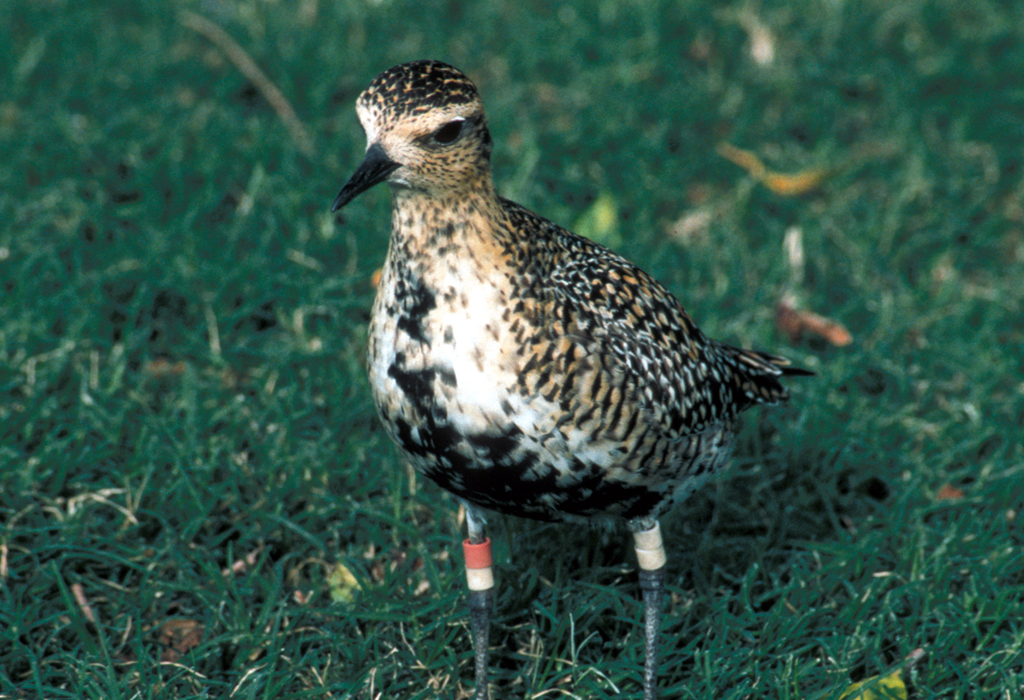Published in the Ocean Watch column, Honolulu Star-Advertiser © Susan Scot
April 20, 2007
You don’t have to be a plover lover (the two words rhyme) to notice these shorebirds’ stunning spring outfits.
The colors of the kolea prancing around my condominium complex are so gorgeous this week, they practically shout at me to slow down and admire them.
I’ve been doing that but the kolea couldn’t care less. Right now, these migratory birds’ only interest is in gaining enough weight to fly the thousands of miles to their northern breeding grounds. There, the birds will focus on attracting a member of the opposite sex. And the finer the feathers, the better the chance. Striking breeding plumage shows a potential partner that the bird is healthy, fit and up to the task of raising a family.
Even if our plovers don’t care much about us, we Hawaii residents care a lot about them. And now we can do something to help them, too. All we have to do is look at their legs.
Longtime plover researcher Wally Johnson has applied both metal and colored bands to selected plovers at Johnston Atoll, Saipan and American Samoa. His purpose is to determine the route plovers take to get to their northern breeding grounds.
Some of these birds, he believes, are going to Alaska, but he wonders if on the long way north, they stop for a rest in Hawaii. He thinks the Saipan birds go to Siberia, via Japan or Mongolia, but no one knows that for sure.
Each selected plover wears a metal band plus a unique combination of colored ones. If you spot a banded bird, it’s important to record the exact sequence on each leg, and note whether the colored band is above or below the metal one. E-mail your observation to owjohnson2105@aol.com.
Keep the binoculars handy. A sighting in Hawaii of any of these banded birds would be a major breakthrough in Johnson’s research.
Every time I write about our plovers, or any migratory shorebirds, I marvel at the distances they travel. When I saw Pacific golden plovers throughout the South Pacific last year, including Australia, I thought surely these individuals migrated to South America or some other Southern Hemisphere place to breed.
But no. Like all other members of their species, these 3- to 7-ounce birds fly to the Arctic and back each year. They probably stop to rest and feed along the way, but still, it seems like a colossal waste of time and energy. Why not just stay in the tropics and raise the kids? If there’s enough food for migrating adults to fatten up, surely there’s enough for chicks to eat.
Not so. Shorebird migration evolved the way it did for a reason, and that’s food supply. The birds move from one seasonally abundant food source to another. And even though bad weather and exhaustion kills thousands each year, migrating these long distances gives their chicks the best chance of surviving.
You can learn more about plovers and the current research from Dr. Johnson himself, who is speaking about his plover studies on Thursday at Windward Community College. The talk begins at 7 p.m.
I enjoy Wally’s lectures and learn new facts each time I hear one. So treat yourselves, citizen members of the kolea research team. Surrounding yourselves with fellow plover lovers is always a good time.
 Credit: U. S. Fish and Wildlife Service
Credit: U. S. Fish and Wildlife Service
Photo by OW Johnson/U.S. Fish and Wildlife Service
Honolulu, HI